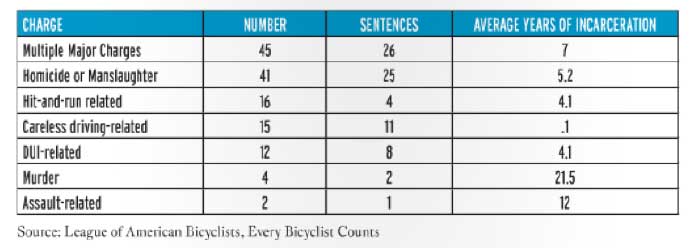In discussions of street safety there is a tendency to view traffic fatalities as isolated incidents or just another statistic. It’s important to reinforce the human element of these crashes: people are injured or killed in our own neighborhoods more frequently than we realize. We’ve recently looked at the Dangerous by Design report by the Complete Streets Coalition, which tracks all pedestrian fatalities across the country, maps them, and examines the factors that caused them. The League of American Bicyclists have undertaken a similar effort, Every Bicyclist Counts, to track bicyclist fatalities across the country.
A key challenge with tracking fatalities of bicyclists has been inadequate data at the national level. Data is reported in only general terms—we know 726 bicyclists were killed in the U.S. in 2012, but we don’t have any additional information to guide policy decisions apart from the seldom-published Fatality Analysis Reporting System (FARS) (last released in 2010). What factors contributed to bicyclists getting killed? Who are the people getting killed? What measures can be taken to prevent future injuries and deaths? Every Bicyclist Counts seeks to document every fatal crash involving a bicyclist in 2012 to assess why the crashes were happening, what was done as a result, if blame was assigned, how the motorists were treated, and whether there were consequences for motorists if they were deemed to be at fault.
 Every Bicyclist Counts collected data for 628 of the 726 bicyclist fatalities in 2012 (mapped here), and uncovered some interesting results. A plurality of crashes were “hit from behind” incidents—indicating that bicyclists traveling in a mixed lane without separation are at higher risk than expected. Of the 238 fatal crashes in which an additional factor was reported for the driver, 42 percent were reported to be driving in a careless or inattentive manner, 36 percent were hit and runs, and 12 percent were driving under the influence of alcohol or drugs. For the 94 fatal crashes in which an additional factor was reported for the bicyclist, 23 percent were reported to be riding the wrong way, 17 percent were reported to have failed to yield, and nine percent were reported to have been riding on the sidewalk.
Every Bicyclist Counts collected data for 628 of the 726 bicyclist fatalities in 2012 (mapped here), and uncovered some interesting results. A plurality of crashes were “hit from behind” incidents—indicating that bicyclists traveling in a mixed lane without separation are at higher risk than expected. Of the 238 fatal crashes in which an additional factor was reported for the driver, 42 percent were reported to be driving in a careless or inattentive manner, 36 percent were hit and runs, and 12 percent were driving under the influence of alcohol or drugs. For the 94 fatal crashes in which an additional factor was reported for the bicyclist, 23 percent were reported to be riding the wrong way, 17 percent were reported to have failed to yield, and nine percent were reported to have been riding on the sidewalk.
While safe cycling practices may mitigate risk of collision, this data suggests that most collisions are outside of the bicyclists’ control: helmets, for example, reduce risk of serious injury, yet 57 percent of bicyclists killed wore helmets. Data from FARS indicates that 56 percent of all bicyclist fatalities are on high speed urban, suburban, and rural arterial roads—Dangerous by Design found that more than half of pedestrian fatalities also occur on arterials. It is clear that safer driver behavior and street designs are necessary.
There is incomplete data on the consequences of these fatal crashes and subsequent enforcement, but it sheds some light on how these cases are generally handled. For many of these crashes, it’s unclear who was at fault. For 285 of the 633 reported fatal crashes, either the obituary or public data indicated a potential enforcement action, such as a citation, arrest, or charge. Of those, final sentences were found for 77 cases (12 percent), including a surprisingly low rate of sentencing for charges of homicide (25 of 41 cases sentenced), hit and run (4 of 16), and DUI (8 of 12). In some states, including Louisiana, South Carolina, and Texas, sentences were found to be less common. When drivers are sentenced, the penalties are often light: DUI and Hit and Run sentences average four years of incarceration, while homicide or manslaughter average five year sentences.

Reports like Every Bicyclists Counts and Dangerous by Design are important because it underscores the need for a national commitment to pedestrian and bicycle safety: investments in walking and bicycling are not “non essential” spending; they are crucial to create safe, equitable, active, and sustainable streets. We need policies and performance measures that hold local, state, and federal governments accountable for the safety of our families, friends, and neighbors. We simply do not spend enough on street safety: between 2009 and 2013, only 0.4% of Highway Safety Improvement Program funds were spent on bicycle and pedestrian safety despite the fact that 15% of fatalities during that period were bicyclists and pedestrians. These reports are critical to changing the conversation and reinforcing the need for complete streets investments across the country, so kudos to the League of American Bicyclists for putting together such an extensively researched report.

